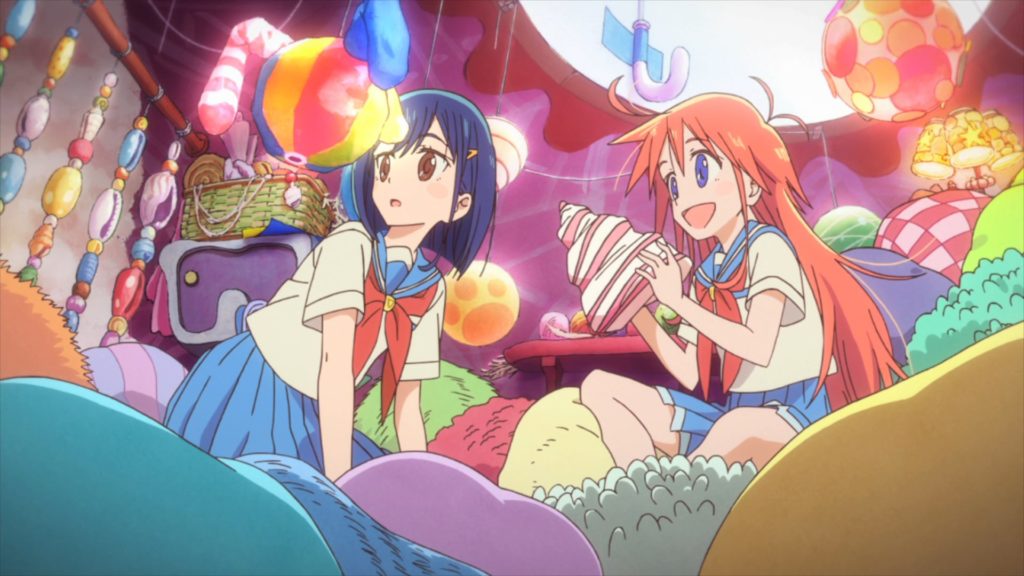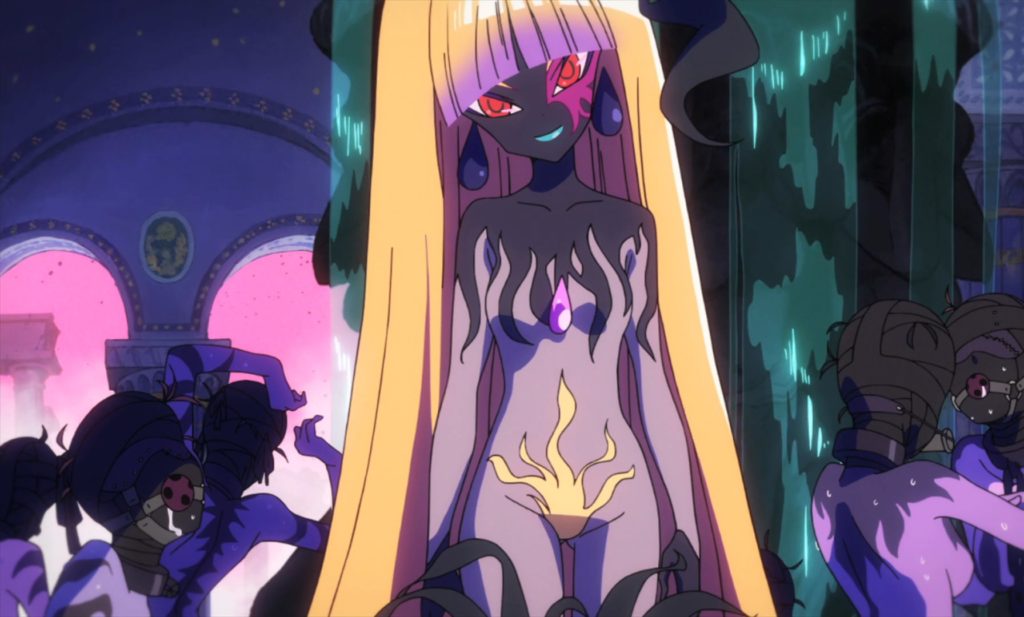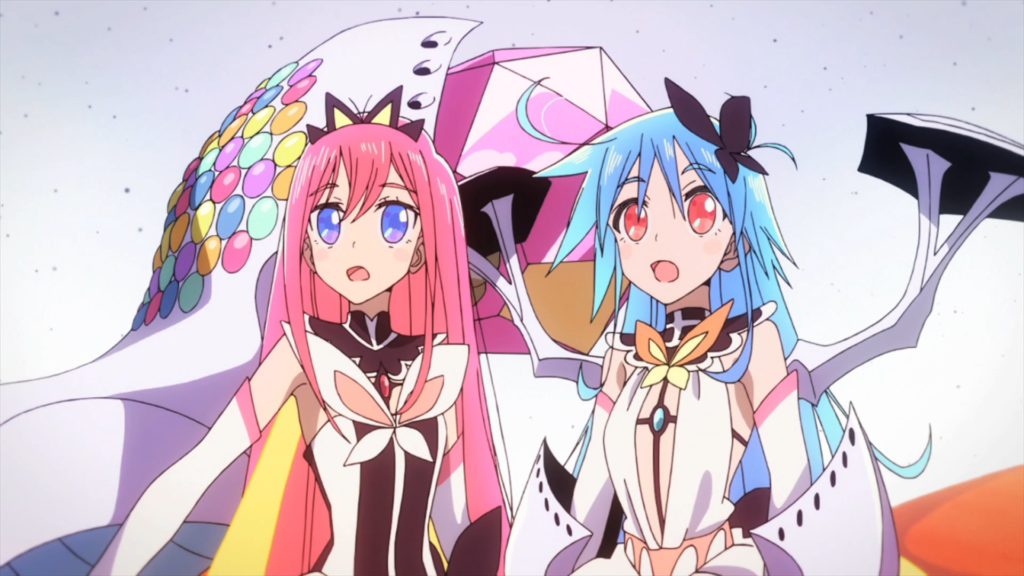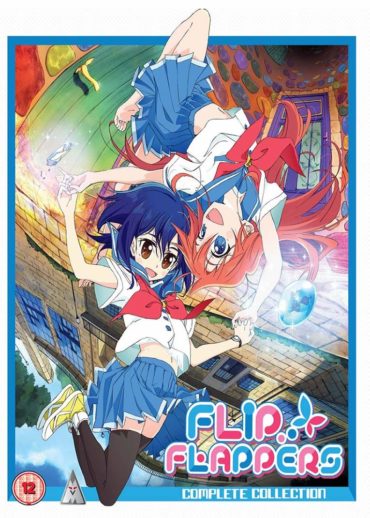Flip Flappers Complete Collection Review
Cocona’s life is a simple one: she’s a pre-teen student living with her grandmother, trying her best at middle school but with little direction in her life. That is, until an energetic girl by the name of Papika suddenly storms into her life on a hover board, and seems to take an instant interest in her. The next thing she knows, Cocona is being dragged to the organisation known as Flip Flap and shown the mystery of Pure Illusion, where multiple and infinite dimensions exist. If someone can gather the magical fragments that lie in these Pure Illusions, then any wish can be granted. And so Cocona starts her wild adventures with Papika – but they are not the only ones after such a prize…
In a post-Puella Magi Madoka Magica world, in order to make a Magical Girl series and have it stand out against a crowd, anime production companies take one of three routes: either they go full throttle with the cuteness and old school tropes so we end up with the likes of Pretty Cure, or they produce a parody/comedy that makes fun of said tropes a la Cute High Earth Defence Club LOVE, or they make it as edgy as possible and have every cute girl suffer, with Magical Girl Site being a more recent and extreme example. There are a few series that lie comfortably in between each camp, and some try their hardest to make theirs the next big thing in the Magical Girl genre, but none have come close to Madoka Magica or even older beloved entries such as Princess Tutu or Sailor Moon. The problem with makers of these series is that they often take away the wrong lesson as to why these series succeed in the first place. Some of their popularity would be due to timing and marketing push but Madoka Magica (for example) wasn’t a success because it had cute girls suffering in a dark and tragic story, it was a success because it was a great and excellently told story that just happened to have cute designs for the heroines and dark elements in the plot that worked within the context of the tale. Flip Flappers, for the most part, seems to understand this and, looking back on the whole series, you can see that it tries to not only tell an interesting story but also strike the right balance between the light and dark aspects of the genre. Sadly, for all of its efforts, it doesn’t reach the heights it goes for and instead ends up as a mediocre series.

First impressions of the anime made me think of another magical girl property that MVM also released this year and I reviewed: Matoi the Sacred Slayer. Both are anime not based on a pre-existing manga, use the concept of ‘dimensions’ and their unique properties not only as a motive to drive the characters but to provide the plot’s conflict, and both series have a main heroine who is dragged into the story via outside forces. However, despite a few similar ideas, the themes and tones are very different. Matoi the Sacred Slayer gives the main character several family members and friends that exist on the outskirts of her secret Magical Girl life, with the relationship with her father serving as the story’s emotional core, and the series leans heavy into its Magical Girl tropes from the offset. Flip Flappers on the other hand goes for a more Alice in Wonderland-meets-science fantasy atmosphere, not really showing its Magical Girl chops fully until the third episode where we get our first transformation sequence, and our heroine has little to no emotional attachment to the ‘real world’ that keeps her character grounded, instead a lot of it crosses over to the Pure Illusions she visits as the series progresses. In the first two thirds of the series, the episodes are self-contained stories that take place in a new dimension each time, and it’s here that the visual design really flourishes as each one sells a completely different tone and challenge for our heroines. There’s a Pure Illusion that seems to be anime’s answer to Mad Max, one that plays like a crossover between Tron and Giant Robot/Mecha shows, and my personal favourite takes place inside a haunted all-girls school with an incredibly absorbing and creepy atmosphere. Their episodic nature works well as one provides lots of action, whilst another provides mystery, so for the first two thirds of the show, half the fun is finding out what fresh experience we’ll find ourselves in.
Then the last third of the show comes in like a punch to the gut, as the plot kicks into full gear with revelations and shock betrayals happening left and right, all leading into an explosive finale. The tone and mood of these episodes are quite a contrast to the monster-of-the-week formula the majority of the series has, and this is where Flip Flappers‘s second biggest problem lies. The plot really doesn’t actually get going until Episode 9, and by then the majority of the audience who were waiting for it to happen would have moved on. There are some subtle nods to the bigger plot building in the background and a conspiracy from an opposing company that the audience gets brief glimpses of, but due to the self-contained nature of the first batch of episodes, what little attempt at foreshadowing is made falls flat. This is due to either introducing characters that seem important but never actually come into play during the finale, or worse, the main heroines themselves are faced with plot-important information, only to completely ignore it until episodes later. That isn’t foreshadowing, it’s baiting the audience to stick around and stopping characters from progressing until the writers think it’s time to get things moving. This ultimately leads them to shoot themselves in the foot with an exposition dump from Episode 9 onwards with little to no breathing space and several characters having to make jumps in logic or switch personalities to make it all work out in the end. That’s not to say that there’s no potential here, because there most certainly is, but no amount of good ideas can remain unscathed by poor implementation and story pacing.

I said earlier that the plot progression is the series’ second biggest problem. By itself that’s a big deal breaker, but there’s one other that drags Flip Flappers down, and that’s the sexualisation of its heroines. Despite the fact that most of the girls in the show are middle schoolers (they’re between the ages of 11 – 13) the series has many camera angles of their bums, thighs and crotches, leading to scenes where the characters are either naked or in sexualised costumes and/or positions within a frame, and a few times when grown men are ogling them in their very skimpy outfits. There’s also a heavy yuri subtext going on, especially towards the latter half of the series, but none of it feels like it comes from a good place. It tries to sell their relationship to you as pure, fun, and genuine, but the heavy reliance on fan service pushes those attempts from intimate into uncomfortable attempts at sexiness. If you’re able to look past such scenes you’ll likely find the show much more enjoyable, however if fan service using young characters is enough to turn you off, there’s not enough good in this show to help save it.
3Hz is the Japanese studio behind the animation, which doesn’t have an extensive catalogue of anime (only six TV series under its belt, including Flip Flappers), but they do a fairly good job. The sketchy animation style and moe girl designs maybe a turn-off for some, however as previously mentioned they really do put the magic into the Pure Illusions, with every dimension having its own unique look and colour scheme. The battles are also fairly competent, even if a few cutaways scenes can get a bit choppy whilst following the action.
The anime is licensed in the UK for DVD and Blu-ray, with a Collector’s Edition on Blu-ray containing a special box, art book and bookmark. For all editions, the on-disc extras include clean opening and closing, English credits, and trailers for Grimoire of Zero and Log Horizon. Japanese and English dubs are included; however, the subs are only available either completely on or off, so if you’re watching the series in English you either remain oblivious to the opening and closing song translations, as well as various Japanese text that’s on screen, or have to manually put it on yourself when required.
Flip Flappers is a hard series to recommend. The first half is bogged down by very slow plot progression and unnecessary sexualisation of underage girls to the point of distraction, but then the second half tries so hard to rush the exposition and emotional drama that, whilst creative, is too little too late. If you’re an avid Magical Girl fan and want something a bit different, Flip Flappers might possibly fill the void, but this is a series that will only be fondly remembered by a small core audience in years to come.



